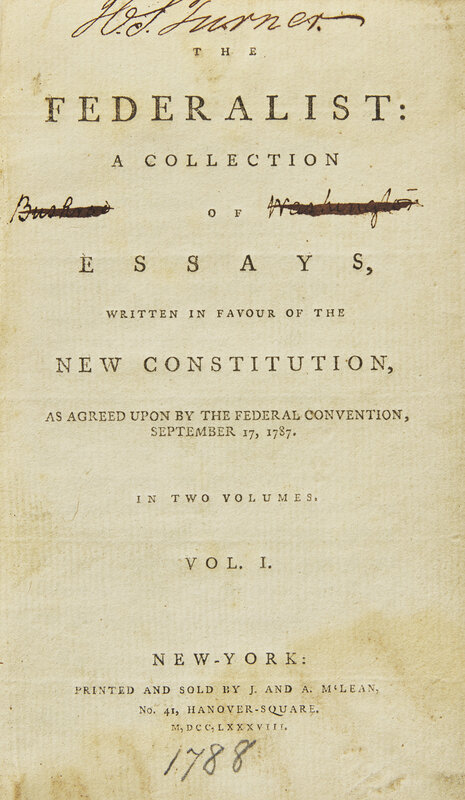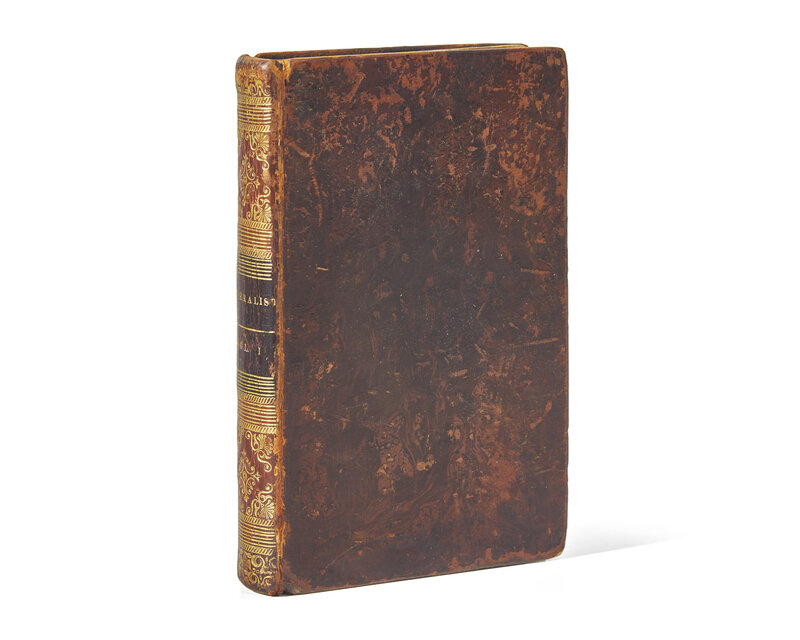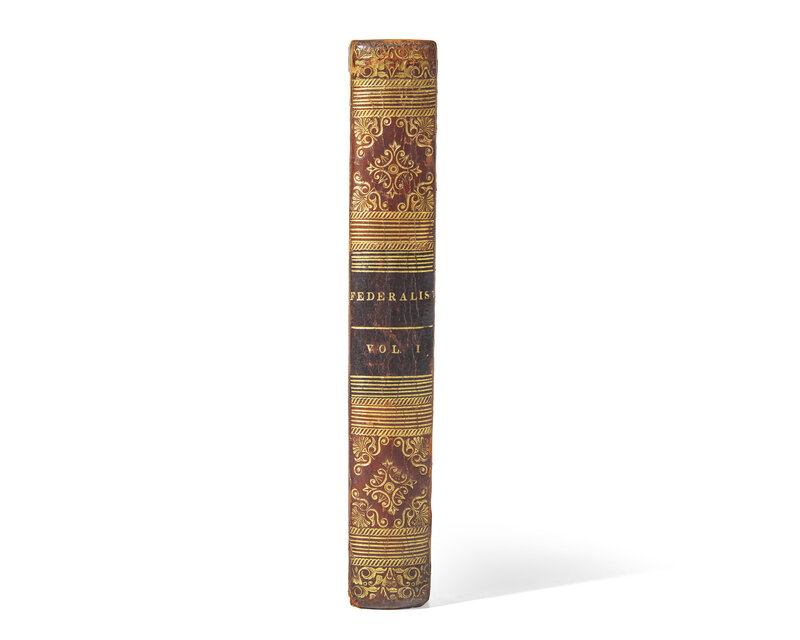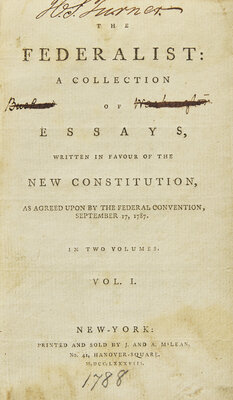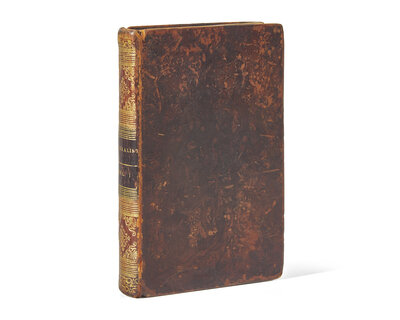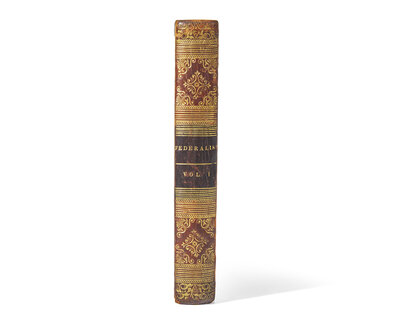Condition Report
Contact Information
Auction Specialist
Lot 34
[Americana] (Hamilton, Alexander, and James Madison, and John Jay).
The Federalist... Bushrod Washington's Copy
The Federalist... Bushrod Washington's Copy
Sale 2101 - Books and Manuscripts
Sep 10, 2024
10:00AM ET
Live / Philadelphia
Own a similar item?
Estimate
$40,000 -
60,000
Price Realized
$53,975
Sold prices are inclusive of Buyer’s Premium
Lot Description
[Americana] [Washington, Bushrod] (Hamilton, Alexander, and James Madison, and John Jay). The Federalist: A Collection of Essays, Written in Favour of the New Constitution, As Agreed Upon by the Federal Convention, September 17, 1787
Bushrod Washington's Copy
New-York: Printed and Sold by J(ohn). and A(ndrew). M'Lean, 1788. Vol. 1 only (of two). First edition, scarce thick paper issue. 12mo, 6 5/16 x 4 in. (160 x 102 mm). vi, 227 pp. From the library of Bushrod Washington, and with his signature on title-page. Full early 19th-century American binding of marbled sheep (ca. 1825-35), spine decorated in gilt, scratching and rubbing to boards, spine, and extremities; brown speckled edges; ownership signature of Bushrod Washington's brother-in-law, Henry Smith Turner (1770-1834) at head of title-page, and with the signature of his son, George Washington Turner (1811-1859), on front paste-down; ownership signature in pencil of Jacob C. Sackman (1844-1923) on front free endpaper, dated September 8, 1864; ownership signature of David S. Seibert in pencil on front blank; Sackman inscription in pencil on rear, "Berryville September 8th 1864". Bushrod's signature crossed out in contemporary ink (possibly by one of the Turners), but still legible; "W" added in manuscript ink next to "B" on signature B1 (p. 13); scattered marginalia in pencil, attributing authorship of some essays ("Hamilton," "J.M.", "Not J.M.", etc.; possibly pre-1818 Gideon edition); ink notation in margin of p. 105 (possibly in Bushrod's hand); dampstaining to endpapers; some leaves at front and rear proud; front free endpaper starting; scattered minor spotting and toning to text. Sabin 23979; Church 1230; Howes H-114 ("c"); Evans 21127; Reese, The Federal Hundred 19; Printing and the Mind of Man 234; Ford 43; Grolier, American 100 19
A fine association copy of the first edition and scarce thick paper issue of volume one of The Federalist. With the ownership signature of Bushrod Washington: George Washington's favorite nephew and principal heir to his library, papers, and his Mount Vernon estate; delegate in the Virginia Ratification Convention who voted in favor of the Constitution's adoption; Associate Justice of the Supreme Court, whose long tenure was instrumental in empowering the young federal judiciary and the national government.
"The most important work in political science that has ever been written, or is likely ever to be written, in the United States" (Rossiter, The Federalist Papers, 1961). The Federalist emerged out of the pamphlet wars that erupted during the state debates over the ratification of the United States Constitution. It was conceived by Alexander Hamilton in the fall of 1787 to promote the Constitution's ratification in New York, where its adoption was highly in doubt. He recruited the assistance of Virginian James Madison and New Yorker John Jay to help create a series of interpretive, and propagandistic, essays defending the new plan of government. Published anonymously under the name Publius, the first essay appeared in New York's Independent Journal on October 27, 1787, and was followed by 84 essays, published in various New York newspapers. In an astonishing rate of production, Hamilton and Madison wrote two essays a-piece per week, at three day intervals, over a seventh month period, totally over 175,000 words (Jay dropped out early due to illness). Of these 85 essays, 51 have been attributed to Hamilton, 29 to Madison, and five to Jay.
In January 1788, New York publishers John and Andrew McLean announced their intent to publish the collected essays of The Federalist in book form. The first volume appeared on March 22, 1788, and contained the first 36 essays, lightly edited by Hamilton, and containing a forward by him, stating that "the great wish is, that it may promote the cause of truth, and lead to a right judgement of the true interests of the community" (p. iv). The second volume, containing the remaining 49 essays (eight of which had not been previously published), appeared two months later, on May 28. Published in only 500 copies, this first edition was printed in two issues: one on regular, thin paper, and a smaller number on deluxe thick paper, as seen in this copy. These thick-paper issues are considerably more scarce and are considered to have been intended for presentation.
Bushrod Washington was 26 years old when he was elected in March 1788 to represent Westmoreland County in Virginia’s ratification convention. The eldest son of George Washington's eldest brother, John Augustine Washington, Bushrod was a novice on the political stage, having been elected to his first role in public office only the previous year in the Virginia House of Delegates. Despite this, he was a gifted and rising attorney, considered "a young gentleman of talents" (Magliocca, Washington's Heir, p. 25). Having studied law at William and Mary College, he served in the American Revolution in a calvary troop, before resuming his legal studies, at George Washington's direction, under the tutelage of Declaration Signer James Wilson in Philadelphia. Upon returning to Virginia in the mid 1780s, he developed political views that would later conform to those of the emerging Federalist Party. He became an ardent supporter of the newly drafted Constitution, no doubt influenced by his illustrious uncle. In late 1787, he wrote to a friend about the Constitution, "I have no doubt that you will discover some imperfections in it, but when it is considered that it is the child of mutual concessions between States different in Situation and Interest, and that without some Efficient Government we must shortly be involved in Anarchy that certain road to Despotism. I think that we should not hesitate concerning its adoption" (Magliocca, p. 25).
When Virginia’s Ratification Convention began in early June 1788, eight states had already voted in favor of ratification. With nine states needed for the Constitution to go into effect, only Virginia, New York, New Hampshire, or North Carolina were left to decide its fate. The outcome in Virginia remained uncertain at the onset of the Convention, and as the largest and most populous state at that time, without its support, the Constitution was likely doomed.
Although the direct effect of The Federalist on the Virginia convention is debatable, some delegates and Virginians sought it out in anticipation for the upcoming contest. George Washington received copies from the authors, and in early April, delegate George Nicholas urged Madison to send him 30-40 copies in order to distribute it among the convention's attendees. By early May, Madison and Hamilton had arranged for copies of the first volume to be sent to Virginia. This included 40 copies on regular paper, and 12 on thick paper, sent by Hamilton to Governor Edmund Randolph, a delegate in the Convention (The Documentary History of the Ratification of the Constitution Digital Edition, Volume IX: Virginia, No. 2, p. 653). Madison himself brought copies with him to distribute to delegates upon his arrival to serve in the Convention, and "Hamilton arranged to supply him with enough copies of both volumes to arm every prominent Federalist in the Virginia ratifying convention with a set" (Bernstein, Are We to Be a Nation?, p. 234). In early April, McLean notified readers of his Virginia newspaper, the Norfolk and Portsmouth Journal, that copies of the first volume were available, and by June, that both volumes could be purchased at his printing office there.
It is uncertain when Bushrod came into possession of this book, but is conceivable that it was around the time of the Virginia Ratification Convention.
One of 170 delegates, Bushrod sat alongside prominent pro-adoption figures like Madison, Edmund Pendleton, his former law professor George Wythe, and a prominent attorney he’d met a few years prior while studying under Wythe, John Marshall. In a little over a decade he and Marshall would go on to serve together on the United States Supreme Court, Marshall as Chief Justice and Bushrod as an Associate Justice, where they would develop and defend lasting interpretations of the very Constitution that they now fought to adopt. The convention met from June 2 to June 27, where the Constitution was debated clause by clause. Despite the protracted schedule, Bushrod attended every session, and voted on every measure, although he is not recorded to have spoken. In the end, the Federalists prevailed over the opposition led by Patrick Henry and George Mason. Ratification was approved by a narrow margin of only 10 votes, according Bushrod's support all the more crucial.
Following the convention, Bushrod returned to private life and continued to practice law, and became one of Virginia's most prominent attorneys. Over the next decade he often argued in front of Virginia’s highest court, alongside and against Marshall, and others from the convention, while being retained for service by the likes of Thomas Jefferson. In 1798, he was appointed to the Supreme Court by President John Adams, filling the vacant seat left by his late legal mentor James Wilson. He was the first appointee of President Adams to the Supreme Court, and at age 36, the youngest appointed at that time. He would serve on the court for the next 31 years until his death, becoming one of the longest serving Justices in its history.
With Marshall's appointment as Chief Justice in 1801, Bushrod would become his principal ally, concurring with him on all but three occasions over his long tenure. In the 28 years they served together, they greatly empowered the judiciary as a coequal branch of the federal government, and interpreted the Constitution in ways that significantly enhanced the powers of the national government, setting lasting precedents that defined the relationship between the central government and the states. This was seen in landmark cases such as Marbury v. Madison (1803), Martin v. Hunter’s Lessee (1816), and McCulloh v. Maryland (1819), among others. Separately, while riding the United States Circuit Court, Bushrod penned his own influential opinions, as seen in States v. Bright (1809); Golden v. Prince (1814); Corfield v. Coryell (1823), and others.
A moderating force on the bench, Bushrod was respected for his judicial skill, steady temperament, and his close readings of the Constitution that informed his legal judgments. Upon Bushrod's death, his colleague Justice Joseph Story reflected, his "mind was solid rather than brilliant; sagacious and searching, rather than quick or eager; slow, but not torpid; steady, but not unyielding; comprehensive, and at the same time cautious; patient in inquiry, forcible in conception, clear in reasoning. He was, by original temperament, mild, conciliating, and candid; and yet he was remarkable for an uncompromising firmness" (Stoner, Jr., Heir Apparent: Bushrod Washington and Federal Justice in the Early Republic, p. 323). Representative Horace Binney similarly observed, "His mind was full, his elocution free, clear and accurate, his command of all about him indisputable. His learning and acuteness were not only equal to the profoundest argument, but often carried Counsel to depths which they had not penetrated" (Faber, Justice Bushrod Washington in the Age of Discovery, p. 805).
This book also bears the ownership inscription of Bushrod's brother-in-law, Henry Smith Turner (1770-1834). Born in Westmoreland County, Turner became a lawyer and served as justice of Westmoreland County, in 1795, was a Federalist representative in the Virginia House of Delegates, from 1799-1800, and owner of the Wheatland plantation in Jefferson County, West Virginia. In 1796 he married Catherine Blackburn (1781-1817), sister of Julia Ann Blackburn (1768-1829), Bushrod's wife of 44 years whom he married in 1785. Following Henry's death, the book was inherited, along with Wheatland, by his son, George Washington Turner (1811-1859). A graduate of West Point, George became a prominent farmer, and was killed by John Brown's men when responding to the latter’s raid on Harper's Ferry, in 1859. The two later inscriptions are from Jacob C. Sackman and David S. Seibert, Union Army soldiers who served in the U.S. Signal Corps. In 1864 they were stationed in Jefferson County, near Harper's Ferry and the Shenandoah Valley, and were likely present for the Battle of Berryville, on September 3-4, 1864.
First editions of The Federalist are rare, even more so with significant associations such as this copy.
